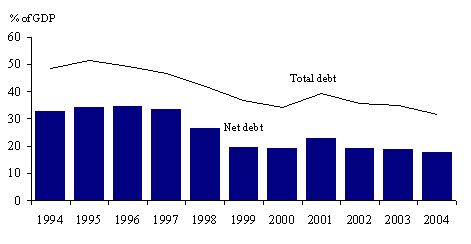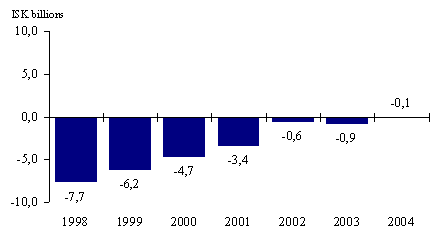News release no. 25/2003. October 1, 2003. The 2004 Fiscal Budget.
|
News Release |
The 2004 Fiscal Budget
The Government Budget for 2004 clearly reflects the new period of economic growth which has begun in Iceland. During this coming year, the heavy industrial projects underway make even greater demands for responsible public finances, to avoid jeopardising the stability which has characterised the Icelandic economy in recent years. Under these conditions, it is important to continue to pursue a policy of restraint in public finances, while at the same time the main emphasis of economic management must be to improve the operating environment for industry. A stable economic situation is a precondition for Icelandic industry to continue to compete successfully with other countries, thereby creating the conditions for increased national revenue and a rising standard of living for Icelanders. The Government's public finance policy until 2007, which is presented in the Budget, marks a turning point in working practices used in economic management in Iceland. It reinforces the credibility of economic policy, enables a better overview of the economic situation and outlook, and encourages continuing economic stability. These are the main objectives of this Budget.
Increased restraint in public finances in 2004.
The proposed budget for 2004 anticipates that the National Treasury will have a revenue balance of ISK 6.4 billion, or the equivalent of x% of GDP. The net financing balance is expected to be even greater, or ISK 13.7 billion. This outcome is in accordance with the Government's main objectives of maintaining balanced public finances and ensuring stability. The year-on-year improvement amounts to over ISK 13 billion, reflecting greatly increased restraint in public finances.
|
Treasury outcome
|
||||
| ISK billions, current prices |
2002
Accounts |
2003
Budget |
2003
Estimates |
2004
Budget |
| Revenue........................................... |
259.2
|
274.2
|
277.2
|
279.4
|
| Expenditure...................................... |
267.3
|
264.8
|
271.0
|
273.0
|
| Revenue balance............................ |
-8.1
|
9.4
|
6.2
|
6.4
|
| Net financing balance.................. |
-3.8
|
19.8
|
17.6
|
13.7
|
Revenue surplus excluding irregular items shows the improved outcome
.
The table below shows the Treasury outcome after adjustment for irregular income and expenditures. Irregular income includes, for instances, profits from sale of assets. Irregular expenditures include, for instance, pension fund obligations expensed and tax claims written off. These figures clearly reflect the impact of the business cycle on the National Treasury. The change from this year to the next is substantial, from a surplus of ISK 1.7 billion in 2003 to an ISK 14.6-billion surplus in 2004. This is due to the economic upturn next year and decreasing government expenditures provided for in the Budget.
|
Revenue surplus excluding irregular items
|
||||
|
2002
Accounts |
2003
Budget |
2003
Estimates |
2004
Budget |
|
| Revenue in excess of expediture.................. |
-8.1
|
9.4
|
6.2
|
6.4
|
| Irregular expenditure.......................................... |
26.3
|
8.5
|
8.5
|
8.7
|
| Irregular revenue................................................. |
11.7
|
12.9
|
13.0
|
0.5
|
| Revenue surplus before irregluar items...... |
6.5
|
5.0
|
1.7
|
14.6
|
Formulating policy for the coming years.
In the medium-term programme presented with the Budget, the Government has formulated its public finance policy for the next four years. Formulating policy for several years at a time increases the credibility of economic policy and places economic management on a firmer footing. Public finance policy will be applied in a concerted manner to restrain domestic demand at the peak of the heavy industrial projects and, similarly, to stimulate economic growth upon their conclusion. Public finances will thus play a key role in economic management in the coming years. Its principal objectives are as follows:
- The Treasury surplus will be at least 1x% of GDP in 2005 and 1% in 2006.
- Public works will be cut back by some ISK 3 billion in 2005 and by ISK 2 billion in 2006. Public works will then be increased by ISK 3 billion in 2007 and by ISK 2 billion in 2008.
- Restraint in government spending will be increased so that the annual growth in public consumption 2005-2007 will not exceed 2% in real terms. Increases in national government wage expenditure, for instance, are not to exceed wage increases in competitive sectors. Furthermore, the annual increase in transfer payments is not to exceed 2S % in real terms in 2006-2007.
- Approximately ISK 20 billion will be used to finance tax cuts 2005-2007 and as much as ISK 3 billion for specific projects, such as increasing child benefits.
|
Medium-term public finance programme
|
||||
| ISK billions, current prices |
2004
Budget |
2005
Estimates |
2006
Estimates |
2007
Estimates |
| Revenue............................................... |
279.4
|
300.0
|
312.8
|
319.7
|
| Expenditure.......................................... |
273.0
|
284.7
|
303.2
|
325.4
|
| Revenue balance................................ |
6.4
|
15.4
|
9.6
|
-5.7
|
| Net financing balance........................ |
13.7
|
7.2
|
8.5
|
-7.4
|
The principal economic premises of the 2004 Budget.
Economic growth is expected to be 3S%, the price level to rise by 2S%, purchasing power to increase by 2S%, employment to be 2S% and the current account deficit to amount to 3R% of GDP. The exchange rate index is assumed to be 125.
Total treasury revenue almost unchanged.
The total treasury revenue next year is estimated to be slightly over ISK 279 billion, or around ISK 2 billion higher than this year's estimated revenue. Tax revenue increases but no income is expected from sale of assets.
Treasury expenses remain constant.
Total government expenditure is estimated at ISK 273 billion, an increase of ISK 2 billion over this year's budget, which is a drop in real terms.
Increased allocations to priority areas.
Despite increased restraint in total national government expenditure, allocations to several priority areas are increased substantially from the previous year. These include, for instance, substantially higher contributions to seniors' pensions, as the result of an agreement reached with senior citizens. Contributions to disability benefits are also increased especially. Health care allocations are also raised, in particular, as a result of additional numbers of hospital beds, additional mental health remedies, and increased contributions to hospital operations. Allocations to education have risen substantially, in particular, to universities and the Icelandic Students' Loan Fund. Allocations to universities, research and upper secondary schools have risen by 49% from 2000 to 2004. Special emphasis is placed on restructuring research by expanding research and technology funds.
Special measures in both revenue and expenditure lead to a better outcome.
In addition to applying increased restraint on expenditure, the Budget proposes special measures which will result in a decrease in expenditure of ISK 3.7 billion. These include, a reduction of ISK 700 million in operating expenditure, of ISK 1500 million in transfer payments and of ISK 1500 in initial new investment. Additional revenue collection amounting to ISK 1000 million is proposed.
Reducing debt continues to be a priority.
The cumulative net financing balance during the period 1998-2004 is estimated to amount to some ISK 63.5 billion. Next year the greatest share of this surplus will be once more used to pay off treasury debts, strengthen the Civil Servants' Pension Fund and improve the Treasury's position with the Central Bank. The policy of restraint exercised in recent years has resulted in a very sizeable reduction to the public debt.

Interest payments drop in real terms.
Paying off government debt has succeeded in reducing the Treasury's interest expenditure in real terms in recent years. By a cautious estimate, the interest saved by the government in this manner since 1998 amounts to some ISK 7.6 billion. The figure below shows changes in the Treasury interest balance, i.e. interest income minus interest expenditure, from 1998-2004.

Public finances will continue to play a key role in economic management.
Under current conditions, where there is complete financial market freedom, the role of public finances in economic management has changed. They cannot be applied in the same manner as before, to rapidly alter key economic items. Instead, the role of public finances becomes increasing that of ensuring economic stability in the longer term. This can best be accomplished by ensuring an adequate surplus in the national budget and structuring the country's fiscal environment to encourage cost-efficiency, both in household and corporate operations. This is the objective aimed at.
Information on the Budget Bill and the National Economy – Autumn Report 2003 is available on the Ministry of Finance website: www.ministryoffinance.is.
Ministry of Finance, 1 October 2003
The Budget Proposal 2004 PowerPoint Show (PPS 248K)

